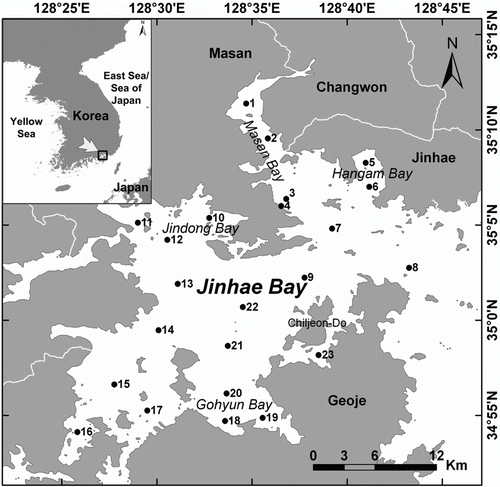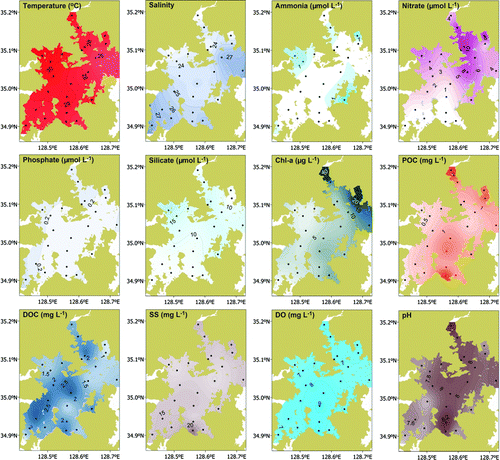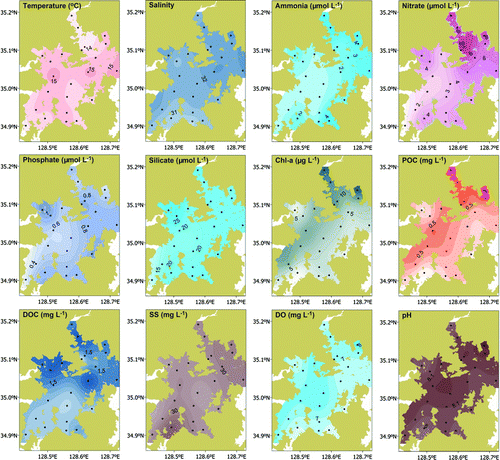Abstract
The chemical and biological characteristics of surface waters in Jinhae Bay were investigated over four seasons to understand water quality in light of the growing industrialisation occurring within this area. Jinhae Bay includes four smaller bays: Masan; Hangam; Jindong; and Gohyun. The water quality in Jinhae Bay varied spatially and seasonally. The water quality of both Hangam Bay and Masan Bay was highly degraded, demonstrating high concentrations of ammonia, nitrate, chlorophyll a and particulate organic carbon. Contamination from sewage was the dominant cause of the water quality deterioration in these bays. Conversely, the water quality in Jindong Bay and Gohyun Bay was not as severely affected as that of the above two bays. Water quality in Jinhae Bay was particularly poor in summer when nutrient loading was highest due to the run-off associated with high precipitation. Principal component analysis indicated that nitrogen contamination was a major factor influencing the water quality of Jinhae Bay. The effective reduction in high-nitrogen discharges is essential to improve water quality in Jinghae Bay.
Introduction
Coastal eutrophication, caused by excessive inputs of nutrients, such as nitrate and phosphate, has been recognised as one of the most serious problems facing marine environments for more than 30 years (Nixon Citation1995). The wide-ranging effects of nutrient enrichment in coastal ecosystems, including eutrophication, pose a significant socioeconomic threat to surrounding areas. The most serious eutrophication impacts in coastal areas are harmful algal blooms, changes in plankton community structure and hypoxia in deep water (Cloern Citation2001). Eutrophication occurs frequently in polluted coastal areas, particularly in estuaries and bays (Livingston Citation2001). To mitigate possible harmful effects of eutrophication, regular water quality monitoring is essential to understand the extent of damage caused by anthropogenic contamination.
Jinhae Bay, the largest bay in Korea, is a semi-enclosed embayment located on the southeastern coast of the Korean Peninsula (). The bay is famous for its spawning and nursery grounds for many marine species involved in aquaculture, including long-line oyster cultures (Crassostrea gigas), mussels (Mytilus edulis) and arkshell bottom cultures (Scapharca broughtonii) (Lim et al. Citation2006). Approximately 7.5% of Jinhae Bay is used for aquaculture, yielding about two-thirds of the total domestic oyster production. Huge industrial complexes were built around the bay beginning in the 1960s, with large amounts of domestic sewage and industrial waste discharged untreated into the bay through several streams (Lee & Min Citation1990). As a result, the water quality of Jinhae Bay has seriously deteriorated, resulting in large-scale algal blooms that began in the early 1980s. Since this time, red tides have occurred annually, causing high mortality of fishery organisms, which has become a crucial socioeconomic issue (Lee & Kim Citation2008). In addition, hypoxia occurring in deep water frequently develops during the summer and extends over much of the bay, covering about 54% of the total area (Lim et al. Citation2006). In an attempt to solve these severe environmental problems stemming from water pollution, the Korean government constructed a wastewater treatment plant (WWTP) to treat sewage and wastewater originating from the cities of Masan, Changwon and Jinhae. Despite this, Jinhae Bay still receives a high load of nutrients and other pollution, with serious eutrophication occurring throughout the bay (Jang et al. Citation2011).
Jinhae Bay consists of several small bays: Masan; Hangam; Jindong; and Gohyun. Masan and Hangam bays are surrounded by the cities of Masan, Changwon and Jinhae, with a total population of approximately one million residents. Most industrial complexes are concentrated around Masan and Hangam Bays; as a result, large amounts of domestic sewage and industrial waste are discharged directly into these bays (Lee & Min Citation1990). These bays are notorious for marine pollution, and are intensively studied due to their long history of pollution (Lee & Min Citation1990; Kang Citation1991; Cho & Chae Citation1998; Lee et al. Citation1998; Kwon et al. Citation2001; Yim et al. Citation2005; Lim et al. Citation2006; Lee & Kim Citation2008; Jang et al. Citation2011). However, few studies have been conducted in Jindong and Gohyun Bays, which are less urbanised and industrialised than Masan and Hangam Bays. Therefore, little is known about the seasonal water quality in the former bays. The present study investigated the spatial and temporal variation in nutrient concentrations, chlorophyll a, particulate organic carbon (POC), dissolved organic carbon (DOC), suspended solids (SS), dissolved oxygen (DO) and pH in the surface waters of Jinhae Bay, including all four smaller bays, over four seasons to determine the major factors affecting water quality in the bay.
Materials and methods
Jinhae Bay is a semi-enclosed bay that opens into the Korea Strait; it has an approximate area of 497 km2, with a mean water depth of 20 m (). Annual precipitation in Jinhae Bay is about 1,500 mm, and approximately 60% of annual precipitation is concentrated in summer (Korean Meteorological Administration Citation2010). Air temperature rises up to 35°C in summer and falls below −5°C in winter (Korean Meteorological Administration 2010). The bay experiences strong semi-diurnal tidal currents of approximately 100 cm s−1 along the deep channel at the mouth of the bay, with weak currents of less than 10 cm s−1 within the inner bay (Kang Citation1991). The mean tide ranges from about 180 cm to 45 cm during spring and neap tides, respectively. In the inner bay, maximum current velocities are 27 cm s−1 during the spring tide and 9 cm s−1 during the neap tide. Water samples were collected at 23 stations located throughout the bay over four seasons: winter (8–9 February 2010), spring (4–5 May 2010), summer (24–25 August 2010) and autumn (23–24 November 2010). Five sampling stations were located in Masan Bay (1, 2, 3, 4, 7), two were in Hangam Bay (5, 6), four stations were located in Jindong Bay (10, 11, 12, 13) and three stations were in Gohyun Bay (18, 19, 20) (). Seven stations were located in the central part of Jinhae Bay (8, 9, 14, 15, 17, 21, and 22).
Vertical profiles of temperature and salinity were measured with a conductivity-temperature-depth sensor (CTD; Ocean Seven 319, Idronaut Co., Italy). Water samples were taken at the surface (1 m below the surface) and bottom (1 m above the bottom) using a 5 L PVC Niskin sampler (General Oceanics, USA). Water samples for nutrient analysis were filtered through GF/F filter paper (25 mm, pore size 0.45 µm, Whatman, Middlesex, UK), placed in acid-cleaned polyethylene bottles and poisoned with HgCl2 (Kattner Citation1999). Ammonia, nitrate and nitrite (hereafter referred to as nitrate), phosphate and silicate concentrations were analysed in the laboratory using a flow injection autoanalyser (model QuikChem 8000, Lachat, Loveland, CO, USA). Nitrate, phosphate and silicate concentrations were calibrated using brine standard solutions (CSK Standard Solutions, Wako Pure Chemical Industries, Osaka, Japan). Duplicate analyses showed the precision of the silicate, phosphate and nitrate measurements to be 3%, 3% and 2%, respectively. For chlorophyll a measurements, 1.0 L of seawater was immediately filtered onboard the research vessel through a 47 mm diameter GF/F filter (pore size 0.45 µm, Whatman, Middlesex, UK) and then stored at −20 °C until further laboratory analysis. Chlorophyll a was measured using a Turner-designed fluorometer (Turner BioSystems, USA) after extraction with 90% acetone for 24 h in the dark. Water samples for POC and DOC measurements were gently filtered through precombusted 25 mm diameter Whatman GF/F filters for 4 h at 450 °C. The filters and filtered seawater were then stored immediately at −20 °C. Filters were oven dried at 60 °C for two days and weighed for the SS measurement. POC was determined using a CHN analyser (ThermoQuest, Italy) after the sample had been dried and acid-fumed. DOC measurements were collected using a Shimadzu 5000A TOC analyser following the methods of Sharp et al. (Citation1993). DO concentrations were measured using the Winkler back-titration method, and pH was measured using a spectrophotometric method (Dickson et al. Citation2007).
Principal component analysis (PCA) was applied to the seasonally-averaged water quality data from Jinhae Bay to assess the relationships and possible patterns between variables. Prior to performing PCA on the water quality data, variables were standardised so that comparisons could be made between different water quality parameters. Principal components (PCs) generated by PCA are sometimes difficult to interpret; therefore, it is advisable to rotate the PCs by varimax rotation. Varimax rotation can be applied to PCs with eigenvalues greater than 1 to obtain new groups of variables (Kim & Mueller Citation1987). Therefore, the varimax rotation method was used to clarify the relationship between variables and factors. Statistical computation was performed using the XLSTAT 2010 (AddinSoft™) program.
Results
The surface distribution of water quality in Jinhae Bay during the winter is shown in . Surface temperatures ranged from 5.51 to 7.71 °C and surface salinity varied from 29.85 to 33.40 psu. Ammonia concentrations were higher in Masan Bay, with the highest value of 32.6 µmol L−1 observed at station 2. Nitrate concentrations were higher in Hangam Bay, with the highest value of 17.6 µmol L−1 observed at station 5. Phosphate concentrations were higher in Masan and Hangam Bays, and silicate concentrations were higher in Hangam Bay, with the highest value of 16.7 µmol L−1 at station 5. Chlorophyll a concentrations were higher in Masan Bay, ranging from 5.96 to 8.34 µg L−1. POC concentrations ranged from 0.11 to 0.62 mg L−1, with the highest value at station 1, while DOC concentrations varied from 0.88 to 1.59 mg L−1, with the highest value occurring at station 5. SS concentrations were higher in Hangam Bay, with the highest value observed at station 5 (23.8 mg L−1). DO concentrations ranged from 10.1 to 12.2 mg L−1, and pH varied from 8.15 to 8.42.
The surface distribution of water quality in spring is shown in . Surface temperature ranged from 14.6 to 17.9 °C, and surface salinity varied from 26.69 to 28.84 psu. Ammonia concentrations were higher in Hangam Bay, with a maximum of 32.0 µmol L−1 at station 5. The concentration of nitrate was higher in Hangam Bay, with the highest value observed at station 5 (8.2 µmol L−1). Phosphate concentrations were relatively uniform, ranging from 0.17 to 0.37 µmol L−1, while silicate concentrations were higher in Masan Bay, with a maximum of 33.4 µmol L−1 at station 1. Chlorophyll a concentrations were higher in Masan Bay (3.49 to 12.9 µg L−1) and Hangam Bay (11.0 to 15.0 µg L−1). POC concentrations ranged from 0.24 to 1.83 mg L−1, and the concentration of DOC varied from 0.72 to 1.24 mg L−1. The concentration of SS was higher in Masan Bay, with a maximum of 38.0 mg L−1 observed at station 3. DO concentrations ranged from 8.20 to 10.2 mg L−1, with higher values in Masan Bay; the pH varied from 7.52 to 8.00.
Figure 2 Spatial distributions of temperature, salinity, ammonia, nitrate, phosphate, silicate, chlorophyll a, POC, DOC, SS, DO and pH in the surface waters of Jinhae Bay in winter.
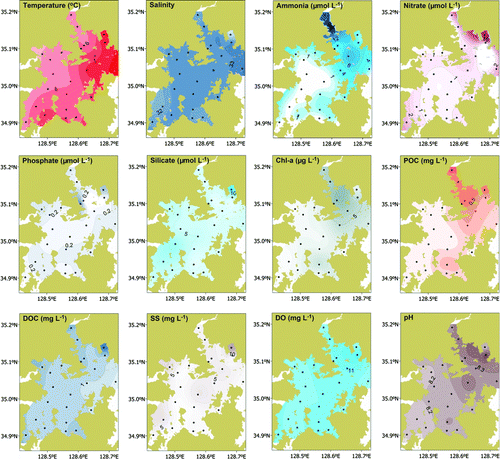
The summer surface distribution of water quality indicators is shown in . Surface temperatures ranged from 25.7 to 31.2 °C, and surface salinity exhibited large spatial variation with a range of 22.12–27.81 psu, with lower values in Masan, Hangam and Jindong Bays, into which several freshwater streams discharge. Ammonia concentrations were generally uniformly low (around 1.0 µmol L−1), and nitrate concentrations were higher in Masan Bay, with a maximum value of 12.2 µmol L−1 observed at station 4. Phosphate concentrations had relatively small variations (0.14–0.34 µmol L−1) compared to the variation in nitrate concentrations (0.10–12.2 µmol L−1). Silicate concentrations were high in Jindong Bay, with a maximum value of 22.6 µmol L−1 observed at station 11. Chlorophyll a showed extremely high concentrations in Masan Bay (5.81–41.8 µg L−1) and Hangam Bay (21.0–28.7 µg L−1), indicating the presence of a phytoplankton bloom. POC concentrations ranged from 0.30 to 2.31 mg L−1, with higher values in Masan and Hangam Bays. DOC concentrations varied from 0.71 to 2.79 mg L−1. SS concentrations were higher in Gohyun Bay, with a maximum value of 31.2 mg L−1 recorded at station 18. DO concentrations ranged from 6.22 to 9.13 mg L−1, and pH varied from 7.30 to 8.29, with the higher values observed in Gohyun Bay.
Figure 3 Spatial distributions of temperature, salinity, ammonia, nitrate, phosphate, silicate, chlorophyll a, POC, DOC, SS, DO and pH in the surface waters of Jinhae Bay in spring.
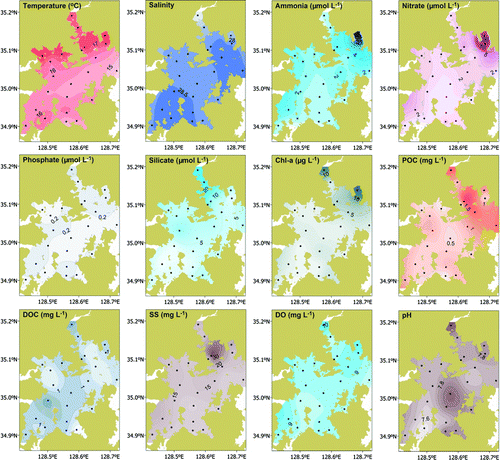
The autumn surface distribution of water quality indicators is shown in . Surface temperatures ranged from 13.7 to 15.2 °C, and surface salinity varied from 30.45 to 32.62 psu, somewhat higher than during spring and summer. The concentration of ammonia was higher in Masan Bay, with the highest value of 4.76 µmol L−1 observed at station 1. Nitrate concentrations were also higher in Masan Bay, with a maximum value of 11.2 µmol L−1 recorded at station 4. Phosphate concentrations were higher in Jindong Bay, with the highest value of 1.08 µmol L−1 occurring at station 11; silicate concentrations were also higher in Jindong Bay, with a maximum value of 31.4 µmol L−1 at station 11. Chlorophyll a concentrations were higher in Masan Bay (5.23 to 15.1 µg L−1) and Hangam Bay (10.3 to 15.8 µg L−1). POC concentrations ranged from 0.12 to 1.09 mg L−1, with higher values in Masan and Hangam Bays; DOC concentration varied from 1.01 to 1.85 mg L−1. SS concentration ranged from 24.7 to 37.3 mg L−1, with a maximum value recorded at station 17. DO concentrations ranged from 6.32 to 8.12 mg L−1, and pH varied from 7.98 to 8.21, with higher values observed in Hangam Bay.
Discussion
Spatial variation in water quality
The four smaller bays that partially comprise Jinhae Bay exhibited different patterns in water quality conditions (). Nutrients, chlorophyll a and POC displayed large variations among these different bays. Annually − averaged concentrations of ammonia, nitrate, chlorophyll a and POC were highest in Hangam Bay, while Masan Bay exhibited the highest concentrations of phosphate and silicate (). Generally, ammonia, nitrate, chlorophyll a and POC concentrations were much higher in Masan and Hangam Bays than in Jindong and Gohyun Bays. Other water quality indicators were not significantly different among the four bays ().
Table 1 Annually-averaged values of water quality parameters in Masan, Hangam, Jindong and Gohyun Bays.
Both Masan Bay and Hangam Bay were heavily urbanised compared to Jindong and Gohyun Bays. Ten freshwater streams, with a discharge rate of 640,707 m3 day−1, flow into Masan Bay (). A WWTP with a treatment capacity of 500,000 m3 day−1 is located around Masan Bay; wastewater from the plant is discharged near station 4 through a submarine outfall. Daily inputs of total nitrogen (TN) and total phosphorus (TP) into Masan Bay from streams and the Masan WWTP were 26,485 and 1781 kg respectively (). Hangam Bay is surrounded by the city of Jinhae, which has a total population of approximately 173,000. Three small freshwater streams with a discharge rate of 148,127 m3 day−1 drain into Hangam Bay (). The Jinhae WWTP, with a treatment capacity of 60,000 m3 day−1, is located around Hangam Bay, and wastewater from the Jinhae WWTP is discharged near station 5 through a submarine outfall. Daily inputs of TN and TP into Hangam Bay through streams and the Jinhae WWTP were estimated to be 1429 and 240 kg respectively (). Daily inputs of TN and TP into Gohyun Bay were similar to those flowing into Jingdong Bay (), both of which were much lower than those flowing into Masan and Hangam Bays. The high inputs of TN and TP into Masan and Hangam Bays are likely due to the discharge of domestic sewage and industrial waste from the surrounding cities.
Table 2 Daily discharge rates of fresh water, total nitrogen (TN) and total phosphorus (TP) into the four bays. Data are from KORDI (Citation1996).
The daily input of TN into Masan Bay was an order of magnitude larger than that entering Hangam Bay; however, annually − averaged ammonia and nitrate concentrations were higher in Hangam Bay than in Masan Bay. This was due to dilution occurring within the geographically larger and deeper Masan Bay as compared to Hangam Bay (). Therefore, higher ammonia and nitrate concentrations in Hangam Bay relative to the other bays may be ascribed to the relatively large input of TN into the small bay. Interestingly, annually-averaged phosphate concentrations were not considerably different among the four bays (), even though the daily inputs of TP into Gohyun and Jingdong Bays were much lower than those into Masan and Hangam Bays (). This was likely due to the larger biological utilisation of phosphate in Masan and Hangam Bays, where chlorophyll a concentrations were much higher than in Gohyun and Jingdong Bays (). Comparing N/P molar ratios among the four bays revealed large variations; the N/P ratio was 24 in Masan Bay, 39 in Hangam Bay, 10 in Jingdong Bay and 7.2 in Gohyun Bay. The N/P ratios in Masan and Hangam Bays were much higher than the Redfield ratio (16), indicating that P is a limiting nutrient for phytoplankton growth. The N/P ratios in Jingdong and Gohyun Bays were lower than the Redfield ratio, indicating that N is a limiting nutrient for phytoplankton growth.
The highest concentrations of chlorophyll a and POC were observed in Hangam Bay, where ammonia and nitrate were the most concentrated form of nutrients. Masan Bay demonstrated the next largest concentrations of ammonia, nitrate, chlorophyll a and POC (). Chlorophyll a and POC concentrations in Jingdong and Gohyun Bays were much lower than those in Hangam and Masan Bays. DOC concentrations did not differ significantly among the four bays (). The much lower concentrations of chlorophyll a in Jingdong and Gohyun Bays can be attributed to lower concentrations of ammonia and nitrate, as the concentrations of phosphate and silicate did not display considerable differences among the four bays. Therefore, spatial variations in chlorophyll a and POC concentrations may be closely associated with spatial changes in ammonia and nitrate concentrations. Water quality in Hangam and Masan Bays is poor, especially considering the high observed concentrations of ammonia, nitrate, chlorophyll a and POC. Hangam and Masan Bays are heavily urbanised; the large volumes of domestic sewage and industrial wastes discharged into these bays may be directly related to the observed degradation in water quality. Jang et al. (Citation2011) also suggested that Masan and Hangam Bays received high nutrient loadings, resulting in serious eutrophication.
Seasonal variations in water quality
Each bay displayed distinct seasonal characteristics in water quality. Surface salinity was lowest in the summer in all four bays (), which may be due to high summer precipitation (approximately 60% of annual precipitation). The summer salinity in Gohyun Bay was somewhat higher than that in the other bays, perhaps because fewer streams drain into Gohyun Bay. Chlorophyll a in the surface waters of all bays showed the highest concentrations during the summer except for Jindong Bay, where the highest concentration was observed in autumn (). The concentration of chlorophyll a during the summer months reached 24.8 and 14.7 µg L−1 in Hangam Bay and Masan Bay, respectively. The summer phytoplankton blooms were mainly dominated by diatoms Skeletonema costatum-like spp. and Pseudo-nitzschia spp (KORDI Citation2011). In this study, chlorophyll a concentrations are negatively correlated with salinity (), implying that phytoplankton biomass increases during the rainy season. Nutrient loads into Jinhae Bay were highest in summer due to the high precipitation, which was supported by the negative correlation between nutrients and salinity (). In summer, the water column was strongly stratified by intense solar radiation and high precipitation, as indicated by the large differences in temperature and salinity between the surface and deeper waters (). Phytoplankton could remain at the surface for a longer time in summer due to this stable water column. Therefore, the negative correlation between chlorophyll a and salinity resulted from the sufficient nutrients and stable water column for the growth of phytoplankton in summer. In tropical areas, however, chlorophyll a concentrations showed strong positive correlation with salinity (Satpathy et al. Citation2010, Citation2011). Satpathy et al. (Citation2010) suggested that lower coastal water salinity during monsoon hamper the growth of phytoplankton.
Figure 6 Seasonal variations in temperature, salinity, ammonia, nitrate, phosphate, silicate, chlorophyll a, POC, DOC, SS, DO and pH in Masan Bay (red line), Hangam Bay (green line), Jindong Bay (blue line) and Gohyun Bay (yellow line).
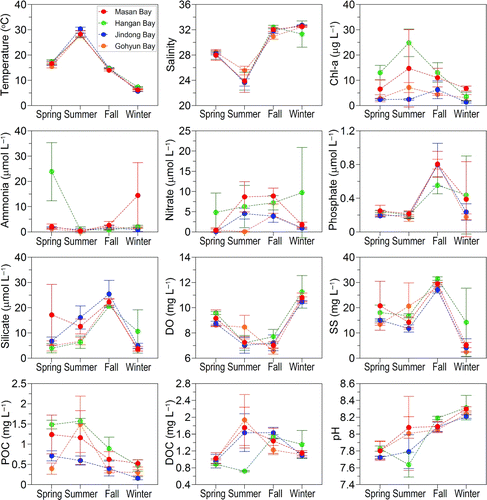
Figure 7 Seasonal variations in temperature, salinity, ammonia, nitrate, phosphate, silicate, chlorophyll a, POC, DOC, SS, DO and pH in surface and deep waters in Jinhae Bay. Closed circles indicate surface water and open circles deep water.
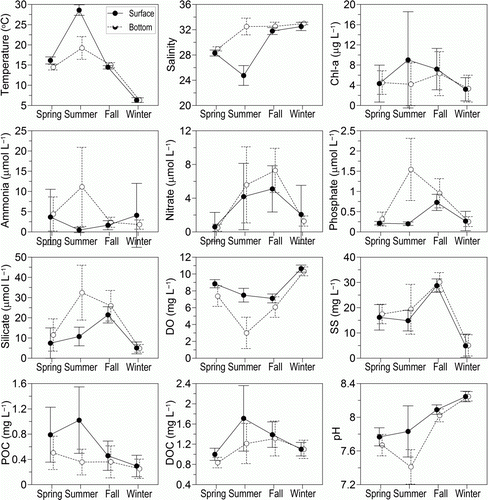
Table 3 Correlation matrix of water quality parameters in the surface waters of Jinhae Bay (P-values < 0.05 are in bold).
Levels of ammonia in the surface waters showed different seasonal patterns among the four bays (); the highest ammonia concentrations were observed in Hangam Bay during spring and in Masan Bay during winter, with Jindong Bay and Gohyun Bay displaying little seasonal variation. Ammonia concentrations are directly related to the microbiological decay of organic matter, with high ammonia concentrations mainly associated with pollution such as domestic sewage and industrial wastewater (Filho et al. Citation2001; Wu & Wang Citation2007; Ho et al. Citation2008). Therefore, the high ammonia concentrations (>10 µmol L−1) found in Hangam Bay in spring and in Masan Bay in winter were probably associated with the influx of domestic sewage and industrial waste. Masan Bay and Hangam Bay are heavily urbanised, with WWTPs located near their shores. The concentrations of ammonia in spring and summer would be high in these bays unless phytoplankton blooms occur during these seasons. Nitrate exhibited different seasonal patterns among the four bays. Surface nitrate concentrations were significantly higher during the spring and summer in Masan and Jindong Bays, while they were higher in Hangam Bay in winter and in Gohyun Bay in autumn (). Large phytoplankton blooms were observed in Hangam and Masan Bays during the summer, corresponding to when nitrate concentrations were substantially higher (>5 µmol L−1). These summer blooms in Hangam and Masan Bays are likely sustained by ammonia, as phytoplankton prefers ammonia to nitrate. Hence, ammonia may be completely exhausted in these bays during the summer. High nitrate concentrations in Hangam Bay during the winter may result from relatively low phytoplankton biomass and their preferential uptake of ammonia.
Unlike nitrate, the seasonal patterns in surface phosphate were similar across all bays. The concentrations of phosphate were highest in autumn and lowest in spring and summer (). Low concentrations of phosphate in spring and summer may be attributed to significant biological uptake by the large phytoplankton blooms occurring during these seasons. The peak of phosphate concentrations in autumn may have been the result of vertical mixing. In summer, the water column is strongly stratified by intense solar radiation and high precipitation. In autumn, however, temperature and salinity differ little between surface and deeper waters (); therefore, stratification becomes weak and vertical mixing may actively occur. In summer, phosphate concentrations are much higher in deeper water than in surface water due to active benthic remineralisation of organic matter and the intense stratification of the water column (). In autumn, vertical mixing brings phosphate enriched deep water to the surface, causing the peak in surface phosphate concentrations. Surface concentrations of silicate exhibited seasonal variations similar to those seen in phosphate, with autumn maxima in all bays (). In summer, silicate concentrations were much higher in deeper water than in surface water (). Thus, the high autumn silicate concentrations are likely due to active vertical mixing occurring during this season.
Concentrations of dissolved oxygen in surface waters were relatively high in winter and low in summer and autumn (). Low DO concentrations in summer result from a decrease in oxygen solubility as water temperature increases. In summer, DO concentrations are much lower in deeper water than in surface water due to benthic respiration and intense stratification (). Low surface DO concentrations in autumn may be ascribed to vertical mixing with oxygen-poor deep water. Concentrations of SS were highest in autumn and lowest in winter in all bays (). The autumn peak in SS concentrations likely results from active vertical mixing and high biological production during this season. The seasonal patterns of POC concentrations were similar in all bays, with high values in spring and summer and low values in winter (except for Gohyun Bay, where high POC concentrations were only observed in summer; ). Summer POC concentrations in Gohyun Bay were similar to those in Hangam Bay, even though the summer chlorophyll a concentrations in Gohyun Bay were almost four times lower than those in Hangam Bay. DOC concentrations were higher in summer and lower in spring in all bays except for Hangam Bay where concentrations were lower in summer (). The observed values of pH were higher in winter and lower in spring in all bays except for Hangam Bay, where lower pH values were observed in summer (). In Hangam Bay, DOC and pH were lower in the summer than in other seasons; additionally, seasonal patterns in DOC and pH were substantially different from those observed in the other bays. The cause of the lower summer DOC and pH levels in Hangam Bay is not yet understood.
Major factors controlling water quality
PCA was applied to seasonally-averaged data to indentify major factors influencing water quality. PCA on 12 water quality parameters from surface water yielded four PCs with eigenvalues > 1, explaining 80.7% of the total variance (). presents PCA results including loadings, eigenvalues and percentages of total variance. PC 1 (29.9% of the total variance) had strong positive loadings for nitrate, ammonia, chlorophyll a, POC and SS, and weak negative loadings for salinity. In this PC, nitrate was well correlated with ammonia (), indicating a common source. Nitrate and ammonia concentrations were fairly high in the heavily urbanised Masan and Hangam Bays (), indicating nitrogen contamination. Ammonia and nitrate were also significantly correlated with the presence of chlorophyll a and POC (). In Jinhae Bay, spatial variations in chlorophyll a and POC concentrations were closely associated with spatial changes in ammonia and nitrate concentrations. In general, dissolved inorganic nitrogen (DIN) showed an inverse relationship with chlorophyll a due to biological uptake of DIN. In this study, a positive relationship between DIN and chlorophyll a indicates that concentrations of DIN were sufficient to compensate for biological uptake, corroborating evidence that nitrate and ammonia originate mainly from sewage contamination. POC was well correlated with SS (), indicating that POC is a major component of SS. Hence, PC 1 was interpreted as nitrogen contamination and biological production.
Table 4 Water quality parameter loadings in the first four Varimax rotated principal components for seasonally averaged water quality data collected from the surface waters of Jinhae Bay (loadings >0.6 are bolded).
PC 2 (19.5% of the variance) had strong positive loadings for phosphate and silicate (). Chlorophyll a was significantly correlated with nitrate, but showed little correlation with phosphate or silicate (). DIN/phosphate and DIN/silicate molar ratios measured in freshwater draining into Masan Bay were 26.2 and 2.76, respectively (Jang et al. Citation2011), indicating that DIN was highly enriched compared with phosphate and silicate. Phosphate and silicate may not be present in sufficient quantities in Jinhae Bay to compensate for biological uptake and thereby they act as limiting nutrients for phytoplankton growth. PC 2 was interpreted as limiting nutrients. PC 3 (17.5% of the variance) had large positive loadings only for pH (). PC 4 (13.9% of the variance) had positive loadings for DOC and temperature, and negative loadings for salinity (). In this PC, DOC was not correlated with temperature or salinity, but salinity was strongly negatively correlated with temperature (), implying that temperature is higher in less saline waters. PC 4 was interpreted as physical influence.
Conclusions
The water quality in Jinhae Bay exhibited spatial variation, with highly degraded water quality in Hangam and Masan Bays. Ammonia, nitrate, chlorophyll a and POC concentrations in Hangam and Masan Bays were several times higher than those in Jindong and Gohyun Bays. Spatial variation in chlorophyll a and POC concentrations was closely associated with spatial changes in ammonia and nitrate concentrations. Chlorophyll a concentrations were extremely high in Hangam and Masan Bays, particularly in summer, reaching 24.8 and 14.7 µg L−1, respectively. Such large summer phytoplankton blooms dominated by diatoms Skeletonema costatum-like spp. and Pseudo-nitzschia spp. are due to nutrient availability and favourable light conditions. Hangam and Masan Bays are heavily urbanised and industrialised; therefore, large volumes of domestic sewage and industrial wastes are regularly discharged into these bays. Daily inputs of TN and TP into Masan Bay were two orders of magnitude greater than those flowing into Jindong and Gohyun Bays. Sewage contamination is a major contributor to the highly degraded water quality in Hangam and Masan Bays. As indicated by PCA, nitrogen contamination is a major factor influencing the water quality of Jinhae Bay. To improve water quality in Jinghae Bay, therefore, more effective management and reduction in high-nitrogen discharges must be pursued.
Acknowledgements
We are indebted to the captain and crew of the R/V Jangmok who were most helpful in all our shipboard operations. The authors also would like to thank Dr Hyun-Ho Shin, Mr Bong-Gil Hyun and Ms Eun-Seon Lee for assistance in the fieldwork. This work was supported by Korea Ocean Research and Development (KORDI) Project PE99151.
References
- Cho HY , Chae JW 1998 . Analysis on the characteristics of the pollutant load in Chinhae·Masan Bay . Journal of Korean Society of Coastal and Ocean Engineers 10 : 132 – 140 ( in Korean with English abstract ).
- Cloern , JE . 2001 . Our evolving conceptual model of the coastal eutrophication problem . Marine Ecological Progress Series , 210 : 223 – 253 . doi: 10.3354/meps210223
- Dickson AG , Sabine CL , Christian JR 2007 . Guide to best practices for ocean CO2 measurements . PICES Special Publication 3 . 191 .
- Filho , JP , Schettin , CA , Rorig , L and Siegle , E . 2001 . Intratidal variation and net transport of dissolved inorganic nutrients, POC and chlorophyll a in the Camboriu River Estuary, Brazil . Estuarine, Coastal and Shelf Science , 53 : 249 – 257 . doi: 10.1006/ecss.2001.0782
- Ho , AYT , Xu , J , Yin , K , Yuan , X , He , L , Jiang , Y , Lee , JHW , Anderson , DM and Harrison , P . 2008 . Seasonal and spatial dynamics of nutrients and phytoplankton biomass in Victoria Harbour and its vicinity before and after sewage abatement . Marine Pollution Bulletin , 57 : 313 – 324 . doi: 10.1016/j.marpolbul.2008.04.035
- Jang , PK , Shin , K , Chang , M and Kim , D . 2011 . Spatial and temporal trends in water quality in response to sewage discharge in Masan and Hangam bays, Korea . Journal of Coastal Research , 27 : 144 – 155 . doi: 10.2112/JCOASTRES-D-11-00023.1
- Kang , SW . 1991 . Circulation and pollutant dispersion in Masan-Jinhae Bay of Korea . Marine Pollution Bulletin , 23 : 37 – 40 . doi: 10.1016/0025-326X(91)90646-A
- Kattner , G . 1999 . Storage of dissolved inorganic nutrients in seawater: poisoning with mercuric chloride . Marine Chemistry , 67 : 61 – 66 . doi: 10.1016/S0304-4203(99)00049-3
- Kim J-O , Mueller CW 1987 . Introduction to factor analysis: what it is and how to do it . Newbury Park , CA , Sage Publications .
- KORDI (Korean Ocean Research and Development Institute) 1996 . A study on coastal zone utilization and integrated management . KORDI Annual Report, BSPN00322-968-7. South Korea, KORDI. 682 p .
- KORDI 2011 . Development of marine ecosystem health index (MEHI) in the special management areas of the South Sea . KORDI Annual Report BSPN98463-2251-3. South Korea, KORDI. 381 p .
- Korean Meteorological Administration 2010 . Weather information . http://web.kma.go.kr (accessed 3 April 2013).
- Kwon , Y , Lee , CW and Ahn , BY . 2001 . Sedimentation pattern and sediments bioavailability in a wastewater discharging area by sequential metal analysis . Microchemical Journal , 68 : 135 – 141 . doi: 10.1016/S0026-265X(00)00140-5
- Lee , MO and Kim , JK . 2008 . Characteristics of algal blooms in the southern coastal waters of Korea . Marine Environmental Research , 65 : 128 – 147 . doi: 10.1016/j.marenvres.2007.09.006
- Lee CW , Kwon YT , Yang KS , Jang PG , Han SD 1998 . Loading characteristics and environmental changes in closed costal water . Journal of Korean Society of Marine Environmental Engineering 1 : 60 – 70 ( in Korean with English abstract ).
- Lee , CW and Min , BY . 1990 . Pollution in Masan Bay, a matter of concern in South Korea . Marine Pollution Bulletin , 21 : 226 – 229 . doi: 10.1016/0025-326X(90)90338-9
- Lim , HS , Diaz , RJ , Hong , JS and Schaffner , LC . 2006 . Hypoxia and benthic community recovery in Korean coastal waters . Marine Pollution Bulletin , 52 : 1517 – 1526 . doi: 10.1016/j.marpolbul.2006.05.013
- Livingston RJ . 2001 . Eutrophication progresses in coastal systems . New York , CRC press .
- Nixon , SW . 1995 . Costal marine eutrophication: a definition, social causes, and future concern . Ophelia , 41 : 199 – 219 .
- Satpathy , KK , Mohanty , AK , Natesan , U , Prasa , MVR and Sarkar , SK . 2010 . Seasonal variation in physicochemical properties of coastal waters of Kalpakkam, east coast of India with special emphasis on nutrients . Environmental Monitoring and Assessment , 164 : 153 – 171 . doi: 10.1007/s10661-009-0882-0
- Satpathy , KK , Mohanty , AK , Sahu , G , Sarguru , S , Sarkar , SK and Natesan , U . 2011 . Spatio-temporal variation in physicochemical properties of coastal waters off Kalpakkam, southeast coast of India, during summer, pre-monsoon and post-monsoon period . Environmental Monitoring and Assessment , 180 : 41 – 62 . doi: 10.1007/s10661-010-1771-2
- Sharp , JH , Benner , R , Benett , L , Carlson , CA , Down , R and Fitzwater , SE . 1993 . A reevaluation of high temperature combustion and chemical oxidation measurements of dissolved organic carbon in seawater . Limnology and Oceanography , 39 : 1774 – 1782 . doi: 10.4319/lo.1993.38.8.1774
- Wu , M-L and Wang , Y-S . 2007 . Using chemometrics to evaluate anthropogenic effects in Daya Bay, China . Estuarine Coastal and Shelf Science , 72 : 732 – 742 . doi: 10.1016/j.ecss.2006.11.032
- Yim , UH , Hong , SH , Shim , WJ , Oh , JR and Chang , M . 2005 . Spatio-temporal distribution and characteristics of PAHs in sediments from Masan Bay, Korea . Marine Pollution Bulletin , 50 : 319 – 326 . doi: 10.1016/j.marpolbul.2004.11.003
